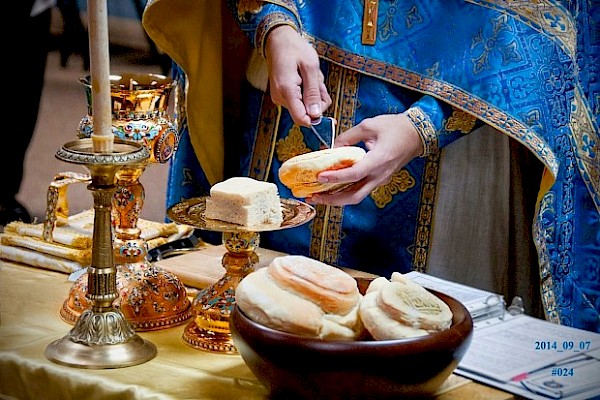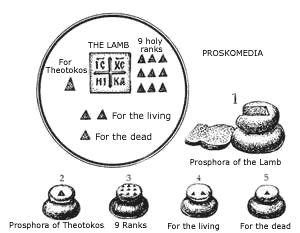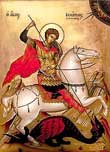St.George Russian Orthodox Church
The Prosphora, Antidoron, Artoklasia

Holy Bread
“And Jesus said unto them, I am the bread of life: he that cometh to me shall never hunger; and he that believeth on me shall never thirst.”
" I am the living bread which came down from heaven; if any one eats of this bread he will live forever; an the bread which I shall give for the life of the world is my flesh"
"Take, eat: this is my body, which is broken for you: this do in remembrance of me"
Bread is used not only to represent Jesus Who is the Bread of Life, of which, if any man eat, he shall never hunger, but also to express the offering of our life to God. The Greek word for altar bread is prosphora which means an offering to God. Bread is used as an offering because it represents life. Once consumed, it becomes part of us, i.e., our flesh and bones.
For us in the twentieth century, bread is just bread. (Except if we are refugees in the Balkans or elsewhere. When we see bread being unloaded from trucks, we only begin to understand its importance!) We can live without it. After all, we have bagels, English muffins, and anything else we want to make, or, more often, buy. Bread is bread! Or is it?
Prosphora
Prosphora is a Greek word meaning “offering.” In one sense, all that we offer for the use of the Church is prosphora: wine, incense, charcoal, oil (for oil lamps), candles, flowers, and bread. Our offerings are never raw materials. In all these cases we take something and make it into something else. Grapes to wine, olives to olive oil, wheat to bread, etc. Generally speaking, prosphora refers to the bread offering. In addition, the bread was not only a gift for use in the Liturgy, but it was also a gift to the Church to feed the priest and the poor.
While its use has remained the same as in the early Church, its form and markings have evolved. Bread with markings and in various shapes was common in ancient times among pagans as well as Christians. People decorated or impressed symbols on bread that was baked, bought, and eaten every day, as well as on bread offered in religious rites.
Details concerning the first Eucharistic loaves are not found in the writings of the early Fathers. “Probably the texts are silent because the forms and symbols were known to all and interpreted correctly. The use of bread in worship was delivered to the Christian communities by practice itself, before any formulation had found a place in the written documents. This is better understood if one remembers that the celebration of the Eucharist predates any written source. The Sacrament was celebrated as soon as a Christian group was formed. In Jerusalem, for example, the Eucharist was performed immediately after Pentecost, that is, twenty years or more before the writing of the Synoptics.” [the Gospels of Matthew, Mark and Luke] (Galavaris, Bread and the Liturgy, p.22)
During the time of Christian persecution, Christian symbols became cryptic, hiding, for example, the cross in simple decorative motifs. Although the symbol used on the bread may have varied during the early years, St. John Chrysostom (4th century) refers to the bread being “sealed,” probably with the IC-XC NIKA.
Prosphora is the name given to the loaves of bread offered during Divine Liturgy in the Orthodox Church. Each individual loaf is referred to as a prosphoron or – in everyday Russian – a prosforka.
In the Russian Orthodox tradition, the loaves are customarily small – around 60mm in diameter – and made in two parts. These represent the two natures of Jesus Christ, divine and human. Before baking, the top of each loaf is stamped with a seal that includes a cross and the letters IC-XC NIKA, meaning “Jesus Christ conquers”. In other Orthodox traditions, the loaves are generally larger with a more elaborate seal.
How are prosphora used?
Before Divine Liturgy begins the priest carefully selects and prepares five prosphora. He then begins a special service of preparation called the prothesis (“setting forth”) or proskomedia (“offering”). This service is done quietly by the priest inside the altar. One of the prosphora prepared is called the “Lamb” and is offered on the Holy Table during Divine Liturgy. When consecrated, it becomes the Body of our Lord Jesus Christ and, when mixed with the consecrated wine that becomes His Blood, a part of Holy Communion. The other four prosphora are used to commemorate the Mother of God, the ranks of saints, and the living and departed. In addition, the people can offer prosphora for themselves and on behalf of their living and departed Orthodox Christian family members and friends. In the Russian tradition the prosphora are purchased at the candle-desk near the entrance to the church. The names of those to be commemorated are written on slips of paper – red for the living and black for the departed – or in a special commemoration book (a “помянник”, in Russian). These names are read out in the altar during the service of preparation and the Divine Liturgy.

What happens to these particles of bread?
At the end of the Divine Liturgy, these particles are placed by the priest or deacon into the chalice holding the Body and Blood of our Lord Jesus Christ. As this is done, the priest or deacon prays: “Wash away by Thy precious Blood, O Lord, the sins of those commemorated here, through the prayers of Thy Saints”. Are any other pieces taken from the prosphora? In addition to the small particles, the priest takes one large wedge-shaped piece from each prosphoron. These pieces of blessed bread are called Antidoron (meaning “instead of the gifts”) and are given to the faithful after Holy Communion. In ancient times the antidoron were given to those who did not receive Holy Communion, but now they are given to all present.
How should prosphora be eaten?
Prosphora is blessed bread and should be handled and eaten with due reverence. Those eating it should take care not to drop crumbs on the floor, and the paper in which it was wrapped should be burned rather than thrown in the rubbish. Any crumbs that fall should be collected and either eaten or burned with the paper. Children eating prosphora should be carefully supervised. From ancient times it has been the custom to eat prosphora on an empty stomach, often with Holy Water or, if appropriate, a little sweet red wine.
Who may take the wrapped prosphora at the end of the service?
The wrapped prosphora may be taken by those who offered them. When this has been done, any prosphora left over may be taken by those who wish to have them.
One of the most concrete and wonderful ways children can participate in the life of the Church is to bake the communion bread.
Bread-making takes a little while, and it calls for patience, but while our hands are busy, we can teach our children about offering (“Prosphora”) and transformation, and the ways in which God will change this bread, and will change us, for the better.
Experienced prosphora bakers will tell you that the baker is transformed by the prosphora, that the effort opens us to God and invites Him to transform us. Indeed, the whole idea of transformation is quite central to bread baking. Prosphora always begins with just four ingredients: wheat flour, water, salt and yeast. Nothing else. Just looking at those ingredients, you know that a transformation must be coming, because this doesn’t look anything like bread.
These four simple ingredients all come to us already dripping with meaning from the Scriptures.
First, the wheat — Christ has taught us to recognize that when wheat dies and is buried, it bursts forth from the ground with new life. Wheat is a symbol of resurrection and life.
To that we add water, remembering how Christ sanctified the water when He was baptized in the Jordan, and how He explained to the Samaritan woman that the water He offers becomes a fountain of living water inside of us, springing up with everlasting life.
Then we add salt, knowing that He called us “the salt of the earth” because we are the preservers of His covenant and because as Christians we flavor the world – the entire world is made better, flavored by our presence in it.
The fourth ingredient is yeast, which is often discussed in the Scriptures, as “leaven”. You may recall that Christ taught that, “The kingdom of heaven is like leaven, which a woman took and hid in three measures of meal till it was all leavened.” (Matthew 13:33) This small amount of yeast will transform everything; once it has been added among the other ingredients, it can never be taken away.
Having gathered our ingredients, we might remind the kids that during the Great Entrance, when the Prosphora is offered, the priest calls out: “Thine own of Thine own we offer unto Thee on behalf of all and for all!”
Artoklasia
The Artoklasia is a service held at the end of Vespers or at the end of Orthros, or even at the end of the Liturgy. Five round loaves of bread are offered by individual faithful as a sign of devotion for personal or family anniversaries such as name days and other occasions bearing close connection with the experience of the Orthodox. The five loaves are reminiscent of the five loaves that Jesus Christ blessed in the desert and by which five thousand of His hearers were fed.
Artoklasia also symbolises and brings into practice the Agape meals of the very early Christian communities. Then, after the faithful received the Body and Blood of Christ, they would gather in a common meal, thus signifying the brotherly association established between them by their common faith and by their receiving the same sacramental Lord. Also, the Agape meals served a charitable purpose by providing meals to the poorer from among them.
The significance behind the Orthodox artoklasia includes also the fact that, among the Orthodox, bread continues to be highly valued not only as a basic food but also as the supreme symbol of the Body of Christ - for it is the bread which is changed by consecration in the Liturgy into the Body of Christ. Christ has been repeatedly designated as the Bread of Life, and also as "the Bread which came from heaven". Bread does also symbolise the Church of Christ, which has spread all over as the wheat on the mountains and which was gathered by Christ into one body. Thus, bread has been given a mystical meaning according to which it constitutes the essence of the spiritual life of the Christian.
The blessed bread of the Orthodox artoklasia has been from ancient times considered to effect personal sanctification and to help the individual against bodily infirmities and illness "if taken with faith". The Greek term "artoklasia" derives from the very words used by the Evangelists in describing the Last Supper at which Christ "broke bread" and offered it to His disciples as His own Body. Also, "bread is broken" in the Orthodox artoklasia, signifying not only an identity in terms but a far more significant affinity between the Lord's and His Church's breaking of bread.
One of the most concrete and wonderful ways children can participate in the life of the Church is to bake the communion bread (Source: Raising Saints) read more...
